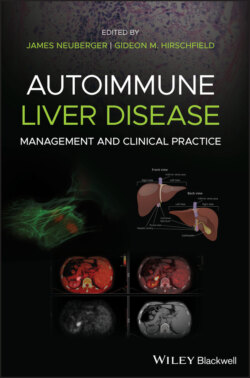Читать книгу Autoimmune Liver Disease - Группа авторов - Страница 26
Apical (Canalicular) Transporters
ОглавлениеVarious ATP‐binding cassette (ABC) transporters mediate the secretion of bile salts and xenobiotics across the canalicular membrane of hepatocytes. These include members of the family of multidrug resistance (MDR) P‐glycoproteins such as MDR1 (ABCB1), MDR3 (ABCB4), and the bile salt export pump (BSEP or ABCB11). Within the family of MDR proteins, BSEP and MDR3 are two highly conserved members that are involved in the secretion of cholephilic compounds from the liver cell into the bile canaliculus.
BSEP constitutes the predominant bile salt efflux system of hepatocytes and mediates the cellular excretion of numerous conjugated bile salts such as taurine‐ or glycine‐conjugated cholate, chenodeoxycholate, and deoxycholate. MDR3 works as an ATP‐dependent phospholipid flippase, translocating phosphatidylcholine from the inner to the outer leaflet of the canalicular membrane. Canalicular phospholipids are then solubilized by canalicular bile salts to form mixed micelles, thereby protecting cholangiocytes from the detergent properties of bile salts.
In addition to these processes, MRP2, the only canalicular member of the MDR‐associated protein family, mediates the canalicular transport of glucuronidated and sulfated bile salts. MRP2 is the main driving force for bile salt‐independent bile flow through canalicular excretion of reduced glutathione. Furthermore, MRP2 transports a wide spectrum of organic anions, including bilirubin diglucuronide, glutathione conjugates, leukotriene C4, and divalent bile salt conjugates, as well as drug substrates such as chemotherapeutic agents and antibiotics.
MDR1 contributes to the canalicular excretion of drugs and other xenobiotics into bile, although its exact contribution has yet to be established. Its broad substrate specificity and its physiologic expression in various tissues with excretory and protective functions make MDR1 one of the major determinants of drug disposition and toxicity. Substrates are neutral and positively charged organic compounds and include various chemotherapeutic and immunosuppressant agents, antiarrhythmic drugs, HIV protease inhibitors, and antifungals.
Transcriptional regulation of BSEP and MDR3 is mediated by FXR and their activation leads to increased bile salt efflux and the formation of mixed micelles in the biliary tree during cholestatic episodes, thereby preventing the toxic effects of bile salts on hepatocytes and cholangiocytes. In addition, FXR has been shown to induce MRP2 expression, which might constitute another compensatory mechanism during cholestasis. In contrast, MDR1 is upregulated via the pregnane X receptor (PXR), which in addition to endogenous ligands is activated by different xenobiotics. This pathway is part of a general cellular mechanism of detoxification, because MDR1 is the key transporter protein involved in the cellular efflux of numerous drugs and xenobiotics.
